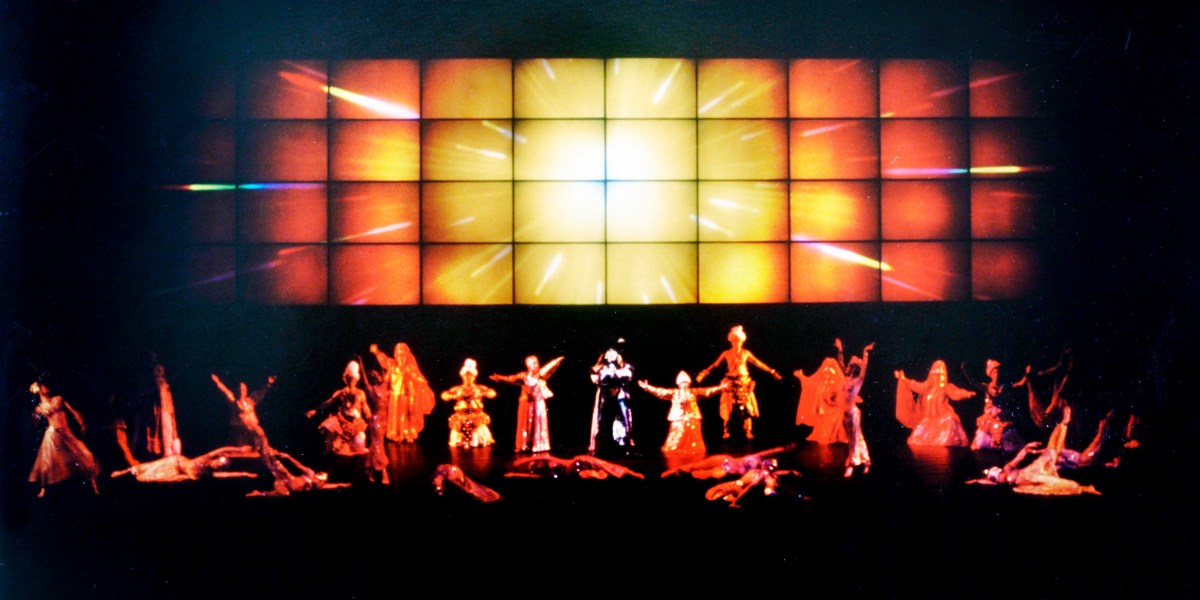This is today’s edition of The Download, our weekday newsletter that provides a daily dose of what’s going on in the world of technology.
Next slide, please: A brief history of the corporate presentation
PowerPoint is everywhere. It’s used in religious sermons; by schoolchildren preparing book reports; at funerals and weddings. In 2010, Microsoft announced that PowerPoint was installed on more than a billion computers worldwide.
But before PowerPoint, and long before even digital projectors, 35-millimeter film slides were king. They were the only medium for the kinds of high-impact presentations given by CEOs and top brass at annual meetings for stockholders, employees, and salespeople.
Known in the business as “multi-image” shows, these presentations required a small army of producers, photographers, and live production staff to pull off. Read this story to delve into the fascinating, flashy history of corporate presentations.
—Claire L. Evans
This story is from the next upcoming issue of our print magazine, which is all about ethics. If you don’t subscribe already, sign up to receive a copy when it publishes.
The US just invested more than $1 billion in carbon removal
The news: The US Department of Energy has announced that it’s providing $1.2 billion to develop regional hubs that can draw down and store away at least 1 million metric tons of carbon dioxide per year as a means of combating climate change.
The details: The first recipients will include Occidental Petroleum’s proposed carbon-removal project in Kleberg County, Texas, as well as a partnership between Battelle, Climeworks, and Heirloom to develop facilities in southwestern Louisiana. Billions of dollars more funding and more hubs are set to be announced further down the line.
Why it matters: A growing body of research has found that, to keep climate change in check, nations may need to not only radically cut greenhouse gas emissions but also draw down billions of tons of carbon dioxide per year. This latest move represents a major step forward in the effort to establish a market for doing this. Read the full story.
—James Temple
AI isn’t great at decoding human emotions. So why are regulators targeting the tech?
Recently regulators have been ramping up warnings against emotion recognition: the attempt to identify a person’s feelings or state of mind using AI analysis of video, facial images, or audio recordings.
The idea isn’t super complicated: the AI model may see an open mouth, squinted eyes, and contracted cheeks with a thrown-back head, for instance, and register it as a laugh, concluding that the subject is happy.
But in practice, this is incredibly complex—and, some argue, a dangerous and invasive example of the sort of pseudoscience that artificial intelligence often produces. But why is this a top concern now? Read this story from senior reporter Tate Ryan-Mosley to find out.
This story is from The Technocrat, Tate’s weekly newsletter giving you the inside track on all things tech, policy and power. Sign up to receive it in your inbox every Friday.
The must-reads
I’ve combed the internet to find you today’s most fun/important/scary/fascinating stories about technology.
1 Survivors say there was no warning siren before the Lahaina wildfires
But it’s unclear what went wrong. (BBC)
+ Researchers are starting to take stock of the losses in Maui. (Science)
+ This is why the wildfires happened—and what can be done to prevent future ones. (Wired $)
2 The clean energy transition is happening faster than you might think
Renewables are now expected to overtake coal as the world’s largest source of electricity by 2025. (NYT $)
+ Yes, we have enough materials to power the world with renewable energy. (MIT Technology Review)
3 Regulators have approved a driverless taxi expansion in San Francisco
Autonomous cabs can now operate across the entire city 24/7. (CNN)
4 TikTok ‘dual’ videos are set to destroy our brains even further
Pity our poor, over-stimulated, already-obliterated attention spans. (Wired $)
+ People are going to extreme lengths to make the perfect TikTok clip. (WSJ $)
5 Why is it so hard to create new types of pain relievers?
The field is littered with failures, but a new study offers a small glimmer of hope. (MIT Technology Review)
6 Why everyone went so crazy over the LK-99 superconductor
The claims don’t seem to stand up. But the episode shows how desperate Silicon Valley is for the next big thing. (WP $)
+ A body of evidence has piled up that disproves the initial claims. (The Verge)
7 AI means hackers can just talk computers into misbehaving
Tools like ChatGPT radically lower the barriers for all sorts of attacks. (WSJ $)
+ Three ways AI chatbots are a security disaster. (MIT Technology Review)
8 How China is using apps to woo Taiwanese teenagers
A perfect example of soft power in action. (The Guardian)
9 How tech is changing how we grieve
We now leave behind reams and reams of stuff online for our families to pore over when we’re gone. (The Atlantic $)
+ Inside the metaverse meetups that let people share on death, grief, and pain. (MIT Technology Review)
10 Zuckerberg says that cage fight isn’t happening
It seems pretty obvious that Musk has chickened out. (BBC)
Quote of the day
“They had an understanding that I wasn’t the best choice — I was the only choice.”
—German director and actor Werner Herzog tells the New York Times why he’s voicing a new collection of AI-generated poems.
The big story
Tech’s new labor movement is harnessing lessons learned a century ago

June 2021
Back in 2020, as the world struggled to cope with the pandemic, workers at the Amazon fulfillment center in Bessemer, Alabama, were being pressed to work harder and longer. They felt dehumanized. They wanted dignity, not just higher wages.
Workers pushed to join the Retail, Wholesale, and Department Store Union, but Amazon waged war on the campaign, and eventually a vote passed in favor of keeping the status quo. Elsewhere, however, other workers across the country had started agitating.
Their activity reflects a new groundswell of interest in organizing among tech workers, who are up against the world’s richest companies. But for both sides in this struggle, the bottom line is not money but power. Read the full story.
—Sarah Jaffe
We can still have nice things
A place for comfort, fun and distraction to brighten up your day. (Got any ideas? Drop me a line or tweet ’em at me.)
+ London’s skater girls surely have to be some of the coolest people on the planet.
+ Let the debate commence over the best 100 movies.
+ You can learn a lot about someone from how they spend their money.
+ Diane Morgan’s Netflix show Cunk on Earth had me in stitches last weekend.
+ A little bit of knowledge can delude us into thinking we know a lot more than we really do. ($)
Denial of responsibility! My Droll is an automatic aggregator of Global media. In each content, the hyperlink to the primary source is specified. All trademarks belong to their rightful owners, and all materials to their authors. For any complaint, please reach us at – [email protected]. We will take necessary action within 24 hours.


